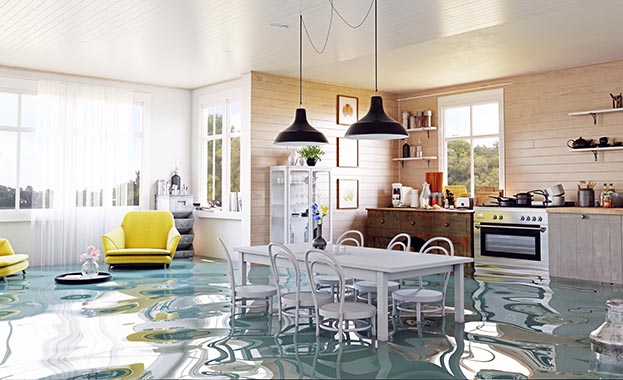As the weather cools across the country, frozen pipes in homes or businesses are a growing risk. Pipes can freeze, swell, and crack, leaving owners with costly flood damage.
Any pipe exposed to temperatures below 20°F for several hours runs the risk of freezing.
The biggest areas at risk are unheated areas, such as in the basement, attic, garage, or crawl spaces, according to Emerson, a global technology, software, and engineering company that serves industrial, commercial, and residential markets. Pipes running along exterior walls with insufficient insulation are also at risk of freezing during the winter.
A crack as small as 1/8-inch in a pipe can spray more than 250 gallons of water a day, causing expensive damage, according to Emerson.
The average insurance claim for water damage from frozen pipes is about $10,000, according to estimates from State Farm Insurance. Also, depending on the policy terms, homeowner’s insurance may not cover the cost of repairing a burst pipe. It may pay only for the water damage.
What Are the Signs?
If a pipe is frozen, there is already about a 50% chance it has cracked. Call a professional immediately if you spot any of these signs, Emerson suggests:
- A bulge or crack in a pipe with ice seeping out is a clear indication of a burst pipe.
- Frost on the outside of a pipe.
- A foul smell from the drain or faucet is a less-obvious warning sign. Odors are unable to filter out of the frozen pipe and instead are forced back into the home’s faucet.
- No water or a slow trickle when a faucet is used.
- Whistling and banging coming from pipes, or strange bubbling sounds when you flush a toilet.
- Dampness, puddles, or rings on drywall or ceilings—signs of an urgent issue.
- In some cases, the pipe may appear fine and a homeowner may not see any signs of small fractures caused by ice expansion.
How to Prevent Frozen Pipes
Emerson recommends the following steps to prevent frozen pipes from damaging your home or business.
- Heating cables: Installing electric heating cables on your pipes is one way to prevent frozen pipes. Combined with an integrated thermostat, this system automatically turns on when temperatures drop below freezing. Heating cables provide the needed warmth to keep pipes from freezing, but not enough to heat the water inside of the pipes. The thermostat controls the system, powering on the cable only when needed. For the best performance, pipe sleeves can be installed over the cable to help retain heat, and plastic pipes can be wrapped in aluminum foil so the heat is dissipated evenly in the pipe.
- Basic maintenance: Prevent frozen pipes with some simple, inexpensive steps. For example, as long as the water's flowing through the pipes, even if it is just a trickle, there's less chance of it forming into ice. Let water drip from the faucets served by exposed pipes on cold days when your home is at risk. Plumbers recommend running water from both the hot and cold taps. Also, keep your thermostat set above 55° F. A constant circulation of warm air may help prevent burst pipes. Leaving cabinet doors open and using a fan to circulate warmer air can help, too, if kitchen or bathroom pipes lie near exterior walls. Emerson also recommends draining and disconnecting garden hoses before cold weather arrives.
- Sleeves and seals: Seal cracks, holes, windows, doors, and other openings along the exterior walls with sealant, caulk, or insulation to prevent frigid air from penetrating the wall cavity. On the interior, insulate and seal attic penetrations such as partition walls, vents, plumbing stacks, and electric and mechanical chases. Pipe sleeves could be useful for pipes that run through the attic or crawl space. The foam pieces should be tight against each other, and users should seal the slits and joints with duct tape. Exterior faucets can also be insulated with foam faucet covers.
Source: Emerson/Easyheat.com













